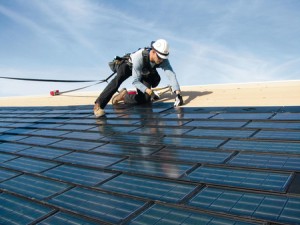The mega-merger between Dow and DuPont has already shaken out an under-performing product line: Powerhouse(TM) solar singles. As reported at PVTech, over 100 jobs in Milpitas, California and in Midland, Michigan will be lost along with the production line that assembles the copper-indium-gallium-sulfide (CIGS) cells into thin-film Building-Integrated PhotoVoltaic (BIPV) rooftop shingles. BIPV markets are very slow to grow due to inherent risk-aversion in considering new building materials, and it has been difficult to cobble together sufficient consumer demand for upgrades to existing roofs to support a profitable business. Dow had offered a 20-year product warranty and optional financing to try to move the market.

“We’re looking at this one product that could generate $5 billion in revenue by 2015 and $10 billion by 2020,” Jane Palmieri, managing director of Dow Solar Solutions, told Reuters in a 2009 interview. Dow had used CIGS cells from Global Solar for a first-generation of the product line, and then acquired NuvoSun in 2013 to own it’s own thin-film CIGS manufacturing technology in anticipation of booming demand for large solar shingles with integrated internal electronics and easy rooftop installation.
When comparing the benefits of different PV product offerings, one factor dominates the decision: all PV installations are area-constrained, and rooftops are extreme examples. The cost of the panel hardware is typically only ~25% of the complete installed system, with Balance Of System (BOS) costs for electronics and installation and financing and permits and non-recurring engineering (NRE). CIGS BIPV may cost less than silicon BIPV, but reduced conversion efficiency means less power can be produced from the roof and when you “do the math” it is always more profitable to use the most efficient PV possible.
Eric Wesoff at GreenTechMedia reported on the status of the thin-film CIGS PV segment of the industry last August when TSMC finally decided to cut losses and shutdown it’s CIGS pilot line. Wesoff reports that over US$2B in Venture Capital investments in CIGS companies has been written-off in the last decade, and that Solar Frontier is the only company selling market competitive CIGS panels with profit.
It is worth noting that the market for solar shingles had been poisoned by pathetic products from UniSolar leaving a severely negative impression on consumers. UniSolar was part of the Energy Conversion Devices portfolio of shell-companies that went bankrupt in 2012, and the UniSolar solar shingles had 6-8% cell efficiency using amorphous-silicon (a-Si) and no integration with electronics such that a hole had to be drilled through the roof for each shingle to connect to a micro-inverter (leading to extreme installation costs and an inherently leaky roof). So unfortunately, Dow faced a severe up-hill-battle in the roofing market to fight against a negative impression of all solar shingles.
—E.K.